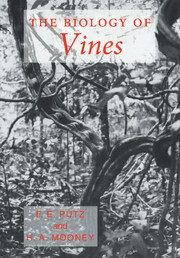Book contents
- Frontmatter
- Contents
- List of contributors
- Foreword
- Preface
- Acknowledgements
- I INTRODUCTION
- II CLIMBING MECHANICS AND STEM FORM
- III VINE PHYSIOLOGY AND DEVELOPMENT
- IV COMMUNITY ECOLOGY OF VINES
- 11 Distribution and abundance of vines in forest communities
- 12 Vines in arid and semi-arid ecosystems
- 13 Vine–host interactions
- 14 Seasonality of climbers: a review and example from Costa Rican dry forest
- 15 Breeding and dispersal systems of lianas
- V ECONOMIC IMPORTANCE OF VINES
- Taxonomic index
- General index
12 - Vines in arid and semi-arid ecosystems
Published online by Cambridge University Press: 05 November 2011
- Frontmatter
- Contents
- List of contributors
- Foreword
- Preface
- Acknowledgements
- I INTRODUCTION
- II CLIMBING MECHANICS AND STEM FORM
- III VINE PHYSIOLOGY AND DEVELOPMENT
- IV COMMUNITY ECOLOGY OF VINES
- 11 Distribution and abundance of vines in forest communities
- 12 Vines in arid and semi-arid ecosystems
- 13 Vine–host interactions
- 14 Seasonality of climbers: a review and example from Costa Rican dry forest
- 15 Breeding and dispersal systems of lianas
- V ECONOMIC IMPORTANCE OF VINES
- Taxonomic index
- General index
Summary
While vines and woody lianas are important growth forms in tropical forest ecosystems, and a noticeable component in many temperate forest ecosystems, they are largely ignored in discussions of the floras of arid and semi-arid ecosystems of the world. Nevertheless, vines represent a small but fascinating component of these floras, and provide insights into modes of adaptive strategies in the tolerance of drought and heat stress. In this chapter we first review the variation in growth forms of arid zone vines, then describe the floristic diversity of vines in mediterranean-type and desert ecosystems, and finally discuss the adaptations of arid zone vines to environmental stress.
Growth forms
Vine species in arid and semi-arid areas of the world occur in a remarkably broad range of growth forms although none of these is unique to such areas. At one extreme are woody lianas, which may occur as both evergreen and deciduous species. Species with this growth form may grow up over shrubs to form their own canopies in full sun, as do tropical lianas, or may grow high into woodland trees while remaining within the shaded canopy of their host species. Ephedra pedunculat, unusual as a liana in the Gymnospermae (Cutler, 1939), has been observed to use telephone poles as a substrate in the Chihuahuan Desert region of south Texas (S. Carlquist, personal communication).
At the other extreme are annual vine species that commonly trail along the ground or grow up into the lower branches of shrubs or suffrutescent species.
- Type
- Chapter
- Information
- The Biology of Vines , pp. 337 - 356Publisher: Cambridge University PressPrint publication year: 1992
- 2
- Cited by



